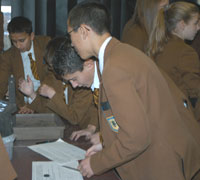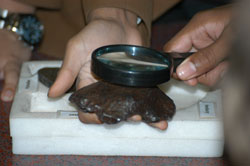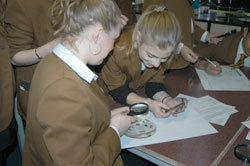Lunar Samples and Lunar Geography at Beal
From the 12th-23rd of January 2004 Beal High School was priviledge enough to have a selection of rocks samples, 'soil' samples and lunar thin sections collected from the surface of the moon, between 1969 and 1972 by NASA. This is possibly the first lunar geography page in the world!
Lunar Geography
While in school all of Key Stage 3 learned about the lunar samples, their origin and the geography and geology of the moon. (Note the animation is a large file and may take time to load)
On the right is a short animation showing the events that led to the formation of the moon.
-
Around 4.6 billion years ago, an object the size of Mars collided with the earth.
-
Upon impact earth material was mixed with the impactor material and the resulting impact caused melting of the rocks. Hence both the new moon and the earth look orange in the animation.
-
After the moon started to coalesce, a lunar magma ocean formed. The denser material in this lunar magma ocean (containing minerals such as iron and magnesium), sank down undrer the crust. The lighter, less dense material 'floated' to the top and formed the crust of the moon. This lunar crust is the white rock, known as anorthosite and is the white parts of the moon that you can see at night.
-
However the moon has also undergone further changes as volcanoes formed and meterorites caused further scaring on the moon and new material has flowed about across the surface of the moon. This material contained the denser iron and magnesium rich basalts associated with volcanism.
Impact Craters
 In addition to learning about the different types of moon rock pupils also examined how and why the surface of the moon is so scarred and cratered. In particular they looked at craters and rays and these were re-created in the classroom by dropping marbles and ball-bearings into trays of sand and powder paint. The powder paint helped to show up the patterns made by the objects as they were dropped so that both the crates and the rays could be measured. The oicture on the left shows Beal pupils measuring the rays. In addition to learning about the different types of moon rock pupils also examined how and why the surface of the moon is so scarred and cratered. In particular they looked at craters and rays and these were re-created in the classroom by dropping marbles and ball-bearings into trays of sand and powder paint. The powder paint helped to show up the patterns made by the objects as they were dropped so that both the crates and the rays could be measured. The oicture on the left shows Beal pupils measuring the rays.
Mystery Rocks - Meteorites
 Pupils enjoyed examining these as they were large and could be handled, the and the weight and textures felt. The sample that you can see on the right is part of an iron meteorite that fell on Henbury in Australia (click on this link to view a 360 degree panorana of the crater that it left behind). The meterorite fargment was very heavy as it was made up of iron (90%) and the remainder from Nickel (8%) and other materials. It is interesting to note that the earth's inner core (see plate tectonics page) is made up of iron and nickel! Pupils enjoyed examining these as they were large and could be handled, the and the weight and textures felt. The sample that you can see on the right is part of an iron meteorite that fell on Henbury in Australia (click on this link to view a 360 degree panorana of the crater that it left behind). The meterorite fargment was very heavy as it was made up of iron (90%) and the remainder from Nickel (8%) and other materials. It is interesting to note that the earth's inner core (see plate tectonics page) is made up of iron and nickel!
The Lunar Samples
 The picture on the left shows pupils from Beal High School examining the lunar sample dic which contained three rock samples and three 'soil' samples (not really soil as it contains no organic matter, but actually a material known as lunar regolith). The white anorthosite was easily identified as was the basalt. However theit was more difficult to pinpoint the origin of the breccia, which contained small pieces of anorthosite in it. A breccia is a rock that is composed of broken angular rock fragments that is contained in a fine matrix (cement). It was fomed when a meteorite hit the surface of the moon creating 'shock metamorphism' - the rock came under intense heat and pressure and the blast caused part of the white anorthsite crust to be broken apart and melted with the dark material. The picture on the left shows pupils from Beal High School examining the lunar sample dic which contained three rock samples and three 'soil' samples (not really soil as it contains no organic matter, but actually a material known as lunar regolith). The white anorthosite was easily identified as was the basalt. However theit was more difficult to pinpoint the origin of the breccia, which contained small pieces of anorthosite in it. A breccia is a rock that is composed of broken angular rock fragments that is contained in a fine matrix (cement). It was fomed when a meteorite hit the surface of the moon creating 'shock metamorphism' - the rock came under intense heat and pressure and the blast caused part of the white anorthsite crust to be broken apart and melted with the dark material.
|